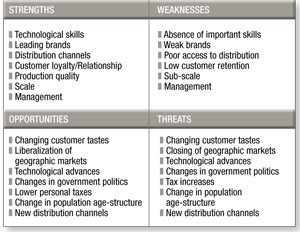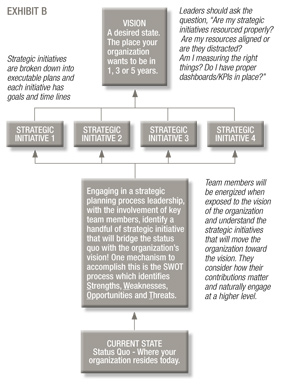The high cost of lackluster leadership
by Tom Halpin
Throughout my career I have had the opportunity to work with all types of organizations, both for profit and non-profit and noticed a common theme of poor leadership. Specifically, I have found that few organizations communicate or illustrate a vision for their employees and constituent groups. Even fewer have identified those strategic initiatives that will bridge where they are today with their vision or desired, future state. And even less have a plan to properly resource those initiatives to transform their organizations. I don’t, for a second, believe that bad leadership is ever the intention of those entrusted to advance organizations. However, for whatever reason, organizational cultures often evolve into centers of mediocrity and, once patterns are established, it becomes very challenging to reverse course.
The objective of this article is to propose a more proactive course of leadership that can be implemented quickly to maximize resources and advance those initiatives that will drive growth and move your organization to a new, better place. Why? Because whether one considers the past, present or future, people always will be an organization’s greatest asset and aligning those resources translates to buckets of opportunity. Resources certainly transcend human capital but all others (process, technology, financial, intellectual) are typically allocated and directed by people.
The premise of my argument is this: You are in business because your value proposition has utility or value. That has been established. But to be sustainable over time, businesses must advance their organizations through resource alignment and by captivating their people with vision. As people buy in, they are able to visualize where and how they fit into the organization and adopt a higher level of ownership. Only then is the table set for leaders to push strategic initiatives down into the organization to support the vision.
Vision is about reinventing one’s self. To quote Charles Darwin, “It is not the strongest of the species that survives, nor the most intelligent, but the one most responsive to change.” Strong leaders understand that the world changes and that complacency is death. You might ask, “This is great, but how do I arrive at a vision for my organization?” It’s not as complex as you might think.
 A SWOT Analysis is a great tool to extract the essence of your organization. SWOT stands for Strengths, Weaknesses, Opportunities and Threats (see Exhibit A). Strengths and Weaknesses are internal and Opportunities and Threats are external. What I’ve found is that, through SWOT, you are always able to cull out organizational core competencies and marry them to new opportunities.
A SWOT Analysis is a great tool to extract the essence of your organization. SWOT stands for Strengths, Weaknesses, Opportunities and Threats (see Exhibit A). Strengths and Weaknesses are internal and Opportunities and Threats are external. What I’ve found is that, through SWOT, you are always able to cull out organizational core competencies and marry them to new opportunities.
As common themes within the SWOT are discovered, you will find that landing on a handful of strategic initiatives to advance the organization is quite easy. If this sounds mystical, it really isn’t at all. If you have the right people in the room, the SWOT process has a high probability of highlighting the most relevant issues to your business. From there, ranking the few, high-impact opportunities will yield the strategic initiatives most
important to your business.
 Exhibit B outlines how the framework comes together from an organization’s current state to its vision. I highly recommend building graphical representations of your vision and strategy as people tend to connect with images. Not only do images of your vision and strategy build team cohesiveness but, if prominently placed in high traffic areas, they keep people aligned. Old school leadership practices believed that vision and strategy
Exhibit B outlines how the framework comes together from an organization’s current state to its vision. I highly recommend building graphical representations of your vision and strategy as people tend to connect with images. Not only do images of your vision and strategy build team cohesiveness but, if prominently placed in high traffic areas, they keep people aligned. Old school leadership practices believed that vision and strategy
belonged in the corporate vault. Today, that is short sighted and unproductive. Shout it from the rooftops, get people on board and lead. If you are concerned that your competition may get wind of this information, don’t worry about it. By the time they know what’s going on, you will be reinventing yourselves again with a new vision and strategy to meet changing marketplace conditions.
As a leader, you’ve been entrusted with much and your people are waiting for you to lead them. Cast the vision, identify the right strategic initiatives and regularly communicate both to your organization. Then allocate and align resources to support the entire plan. Make no mistake about it, this is where money is made or lost.
If you’re always waiting for the perfect idea to move your business forward, stop. Understand your core competencies and work within them. Distractions and misalignment of resources will cost you dearly, not to mention demotivate your team as they meander like lost sheep.
Imagine the power of your team moving in one, unified direction accomplishing more than you dreamed possible. Strong leaders understand it and lead accordingly. Mediocrity? It’s shameful and starts at the top.
 Tom Halpin is president, The Halpin Group, a Michigan-based consulting firm focused on leadership, strategy and revenue generation. He can be reached at tom@thehalpingroup.net.
Tom Halpin is president, The Halpin Group, a Michigan-based consulting firm focused on leadership, strategy and revenue generation. He can be reached at tom@thehalpingroup.net.
This article originally appeared in the Jan./Feb. 2013 issue of Industrial Supply magazine. Copyright 2013, Direct Business Media.













